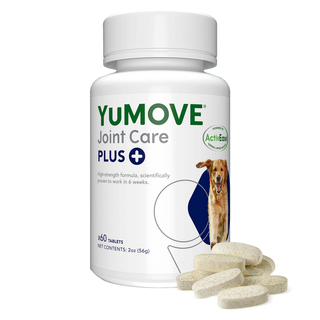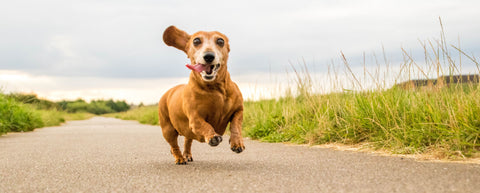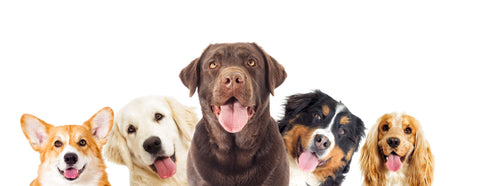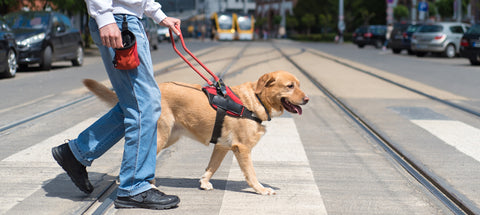As dramatic as it may sound, helping your dog stay cool really is a matter of life and death for them. Their bodies don’t work the same as ours, and when it’s hot they need our help. With this in mind, we’ve got five top tips to keep your dog safe in extreme heat, and five ways to keep them more comfortable in warm weather...
TIPS FOR EXTREME HEAT
1. Don't exercise your dog during a heatwave
We know your dog likes walks – they may even be looking at you, like, “Hey, why aren’t we going for a walk today?”. But you’re their grown-up and you know why. You know it’s way too hot out there, the sidewalks are scorching (it will literally burn their feet), and even a minimal amount of exercise in this heat can cause heatstroke, which can be fatal. This is true for all dogs, especially flat-faced breeds. Playing catch, chase or any kind of game in your home or in the garden is also a no-no, as it’s just too much exertion.
Dogs are not only wearing permanent fur coats, but they also can’t sweat to lose heat like we can. They can only lose heat by panting and through their paw pads – that’s a very small surface area, and not an effective cooling system! As animal charities warn, dogs not only die in hot cars, they’ll die on hot walks. Don’t risk it.
2. Water, water everywhere
Regulating your dog’s body temperature and keeping them hydrated during a heatwave isn’t just a matter of comfort, it’s life or death for them. If in doubt, always err on the side of caution, cool and hydrate your canine companion as much as possible, until the weather normalizes.
Keep your dog’s water bowl topped up with fresh, cool water at all times – you can even add a few ice cubes, and they can lick and eat the ice cubes too!
If your home doesn’t have an AC unit, it’s possible to create a DIY version using only a large tub of water, a fan and a freezer. Simply freeze the large container of water – an ice cream tub should do the trick here – and then set it up in front of a fan that’s been positioned to face your dog. This will create a soothing and continuous current of cool air to help your four-legged friend.
Probably worth putting the fan up on a high surface and tilting it downwards, so your dog can’t knock it over. Other hydro-cooling tips involve draping a chilled, damp towel over your dog, or soaking a bandana in cold water and tying it loosely around their neck (see cooling coats on tip 8 too). Cool (but not freezing cold) baths are another way to keep your canine bud comfortable.
3. Aim a fan directly at your dog
Get that breeze going indoors for your dog! They’ll love a cool place to lie down in front of a fan. Just make sure it’s on a setting they’re comfortable with, as you want them to lie in its breeze and relax.
Think about what they are lying on, too. You can put down a cooling mat for them, or they can lie on the cool tiles/flooring in your home if you have this, or even on a cool wet towel. It’s the safest thing for them to do. There’ll be plenty of time for playing once the super-hot weather passes.

4. Don't travel with your dog in the car
Taking your dog in the car in extreme levels of heat should be avoided. Even with the windows open or AC blasting, it’s too dangerous if your car breaks down. Leaving your dog in the car is also incredibly dangerous, and a huge no, as they can overheat and die even in a short period of time.
If you do need to head out of the house, it’s important that you leave your dog at home in a cool environment with plenty of water. Only travel with them if it’s absolutely necessary, for example if you are taking them to the veterinarian.
If you absolutely must travel with your dog, try to go really early morning or in the evening when the temperature is a little bit cooler.
5. Keep your dog in the shade
While we might love a bit of sunbathing, laying in the sun can be harmful for your dog. If outside in the sun for too long, they may develop heat exhaustion and some white-fur or pink-skinned dogs can burn.
If you can, keep your dog inside and away from direct sun so they don’t overheat. You can let them outside for speedy bathroom breaks, but too long can be too much.
If you’re tight for space inside, then you must set up plenty of shaded areas outside. You can do this with umbrellas, tied up sheets and towels, or solid opaque tables. Make sure there’s plenty of clean, cold water in these shady set-ups and try to set up fans close by to keep a breeze going at all times.
GENERAL TIPS FOR WARM WEATHER
6. Change your dog-walking schedule
If you normally go for walkies with your dog at lunchtime or the early afternoon, swap your schedule for an early-morning walk and a late-evening stroll. This way, you'll avoid the sweltering midday heat.
Also think about where you’re walking. Could you swap open fields for cool woodland walks, or go to places where your dog can cool down in water with a swim?

7. Protect your dog's paws
Do you have an urban dog? If so, don’t forget that sidewalks can get seriously hot! Beach bum dog? That sand can get seriously hot too!
Before heading out, touch-test the ground with your own hand or foot (hold it there for 7 seconds). If it feels hot, don’t ask your dog to walk on it. Their paws will be in contact with the ground for the length of the walk (a lot longer than 7 seconds) and it will literally burn the soles of their feet – very painful, and they won’t be able to walk until it’s healed.
If you absolutely must be out and about on hot sidewalks, you’ll need to get some protective boots for their paws.
8. Get a cooling jacket or vest
A cooling jacket will make your dog feel cool not wet. You can test this by putting your hand beneath your dog’s coat and feeling how cool they are!
Simply immerse the coat in water for a couple of minutes, then once it’s completely saturated, remove and squeeze out the excess water so the coat feels cool and damp but not wet. Put it on your dog – then watch your dog visibly chill out!
It’s the same process as humans use when they sweat to cool down (dogs can’t sweat like we can, one of the reasons they overheat easily). As the heat slowly evaporates the moisture from the cool vest, it creates heat exchange with your dog’s body, leaving them feeling far cooler than before.
Cool coats are great to use indoors if your home is warm and you don’t have AC, and you can use them on outdoor walks to help your dog too (you still need to limit exercise in warm weather, none in extreme heat, and take plenty of water).
There are loads of cooling coats, jackets and vests available these days, to suit every budget, every size dog – and every style! If your dog has joint issues, just make sure the coat you choose can be put on without needing to bend any sore joints (there are loads of options available that work for this).
9. Visit the groomers
If your dog is a breed or mix that can be clipped, get regular trims in summertime. Many double-coated breeds shouldn’t be clipped or trimmed – but will find relief in a thorough grooming to get any insulating dead hair out.

10. Make doggie popsicles – the ‘pupsicle’
We love to make doggie popsicles! You can get as advanced and creative as you like, or simply freeze some of their regular food or treats!
You can also dedicate one of your ice-cube trays to them, for mini frozen treats you can give to them regularly on hot days.
For cold treats without any extra calories, freeze their favorite toys in an old ice cream tubs – they’ll have fun and stay cool whilst freeing their toys from the ice!
How do dogs regulate their body temperature?
Lots of people think that dogs can’t sweat, but this isn’t the case. Our canine friends do have sweat glands but only in their noses and paw pads. Paddling in cool water is an ideal way for them to cool down!
As the areas with sweat glands are so small, dogs mainly keep themselves cool by panting. However, this isn’t the most effective mechanism to regulate your dog's body temperature, so it’s important to keep an eye on them.
Taking the above tips into mind during the hot and warm weather will keep tails wagging and most importantly can help to alleviate the threat of canine heatstroke.
Heatstroke: the danger
Heatstroke is one of the biggest dangers to dogs in warm weather. It can progress very quickly, and even if treated swiftly, can be fatal. It most typically occurs in three different situations:
1. Your dog does too much exercise in warm weather – fun in the sun, playing fetch, walking, running, or playing with doggie friends.
2. Your dog can’t cope with heat for a medical reason – some dogs overheat more than others, particularly overweight dogs, heavy-coated breeds, and short-nosed ‘brachycephalic’ breeds or mixes (that’s Pugs, Boston Terriers, French Bulldogs and Boxers to name a few).
3. Your dog is trapped in a hot environment such as a hot car, or even just a warm, sunny room.
Heatstroke can kill or cause irreparable damage to internal organs, so it’s vital that you take it seriously and do all you can to prevent it. Here's our go-to list of signs which can warn you that your dog might be overheating.

How can I tell if my dog is too hot?
It depends whether we’re talking about a dog who's uncomfortably hot or suffering from heatstroke. It’s important to know the difference – and how to help in both cases.
Signs of a dog who’s too hot:
- Panting
- Dribbling
- Lethargic or restless
- Grumpy or out of sorts
- Off their food
- Drinking lots of cool water
Signs of heatstroke:
- Blue, bright red or dark red tongue and gums
- High body temperature (104°F or more)
- Wobbliness, weakness or staggering
- Seizures
- Collapsing or unconsciousness
- Blood in poos or urine
At YuMOVE we believe that prevention is always the best approach. Keep our ten top tips in mind in warm and hot weather to avoid any risk to your dog, and if you're worried about heatstroke, act fast and contact your nearest veterinary center.
We have more health guides to help you and your dog, and if you’d like us to cover a topic let us know at hello@yumove.com.










